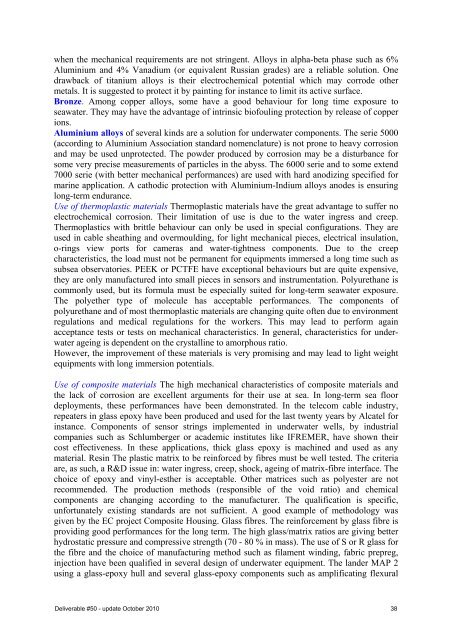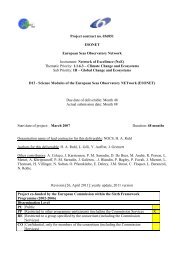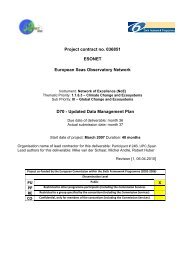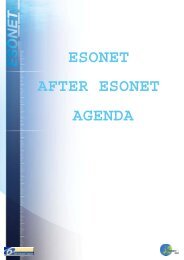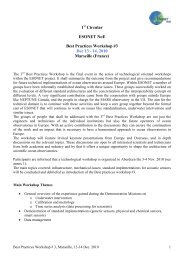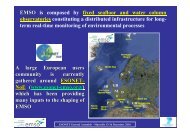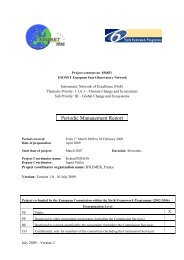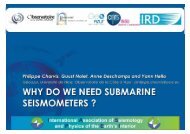Project Deliverable D50 Report on Best Practices ... - ESONET NoE
Project Deliverable D50 Report on Best Practices ... - ESONET NoE
Project Deliverable D50 Report on Best Practices ... - ESONET NoE
Create successful ePaper yourself
Turn your PDF publications into a flip-book with our unique Google optimized e-Paper software.
when the mechanical requirements are not stringent. Alloys in alpha-beta phase such as 6%<br />
Aluminium and 4% Vanadium (or equivalent Russian grades) are a reliable soluti<strong>on</strong>. One<br />
drawback of titanium alloys is their electrochemical potential which may corrode other<br />
metals. It is suggested to protect it by painting for instance to limit its active surface.<br />
Br<strong>on</strong>ze. Am<strong>on</strong>g copper alloys, some have a good behaviour for l<strong>on</strong>g time exposure to<br />
seawater. They may have the advantage of intrinsic biofouling protecti<strong>on</strong> by release of copper<br />
i<strong>on</strong>s.<br />
Aluminium alloys of several kinds are a soluti<strong>on</strong> for underwater comp<strong>on</strong>ents. The serie 5000<br />
(according to Aluminium Associati<strong>on</strong> standard nomenclature) is not pr<strong>on</strong>e to heavy corrosi<strong>on</strong><br />
and may be used unprotected. The powder produced by corrosi<strong>on</strong> may be a disturbance for<br />
some very precise measurements of particles in the abyss. The 6000 serie and to some extend<br />
7000 serie (with better mechanical performances) are used with hard anodizing specified for<br />
marine applicati<strong>on</strong>. A cathodic protecti<strong>on</strong> with Aluminium-Indium alloys anodes is ensuring<br />
l<strong>on</strong>g-term endurance.<br />
Use of thermoplastic materials Thermoplastic materials have the great advantage to suffer no<br />
electrochemical corrosi<strong>on</strong>. Their limitati<strong>on</strong> of use is due to the water ingress and creep.<br />
Thermoplastics with brittle behaviour can <strong>on</strong>ly be used in special c<strong>on</strong>figurati<strong>on</strong>s. They are<br />
used in cable sheathing and overmoulding, for light mechanical pieces, electrical insulati<strong>on</strong>,<br />
o-rings view ports for cameras and water-tightness comp<strong>on</strong>ents. Due to the creep<br />
characteristics, the load must not be permanent for equipments immersed a l<strong>on</strong>g time such as<br />
subsea observatories. PEEK or PCTFE have excepti<strong>on</strong>al behaviours but are quite expensive,<br />
they are <strong>on</strong>ly manufactured into small pieces in sensors and instrumentati<strong>on</strong>. Polyurethane is<br />
comm<strong>on</strong>ly used, but its formula must be especially suited for l<strong>on</strong>g-term seawater exposure.<br />
The polyether type of molecule has acceptable performances. The comp<strong>on</strong>ents of<br />
polyurethane and of most thermoplastic materials are changing quite often due to envir<strong>on</strong>ment<br />
regulati<strong>on</strong>s and medical regulati<strong>on</strong>s for the workers. This may lead to perform again<br />
acceptance tests or tests <strong>on</strong> mechanical characteristics. In general, characteristics for underwater<br />
ageing is dependent <strong>on</strong> the crystalline to amorphous ratio.<br />
However, the improvement of these materials is very promising and may lead to light weight<br />
equipments with l<strong>on</strong>g immersi<strong>on</strong> potentials.<br />
Use of composite materials The high mechanical characteristics of composite materials and<br />
the lack of corrosi<strong>on</strong> are excellent arguments for their use at sea. In l<strong>on</strong>g-term sea floor<br />
deployments, these performances have been dem<strong>on</strong>strated. In the telecom cable industry,<br />
repeaters in glass epoxy have been produced and used for the last twenty years by Alcatel for<br />
instance. Comp<strong>on</strong>ents of sensor strings implemented in underwater wells, by industrial<br />
companies such as Schlumberger or academic institutes like IFREMER, have shown their<br />
cost effectiveness. In these applicati<strong>on</strong>s, thick glass epoxy is machined and used as any<br />
material. Resin The plastic matrix to be reinforced by fibres must be well tested. The criteria<br />
are, as such, a R&D issue in: water ingress, creep, shock, ageing of matrix-fibre interface. The<br />
choice of epoxy and vinyl-esther is acceptable. Other matrices such as polyester are not<br />
recommended. The producti<strong>on</strong> methods (resp<strong>on</strong>sible of the void ratio) and chemical<br />
comp<strong>on</strong>ents are changing according to the manufacturer. The qualificati<strong>on</strong> is specific,<br />
unfortunately existing standards are not sufficient. A good example of methodology was<br />
given by the EC project Composite Housing. Glass fibres. The reinforcement by glass fibre is<br />
providing good performances for the l<strong>on</strong>g term. The high glass/matrix ratios are giving better<br />
hydrostatic pressure and compressive strength (70 - 80 % in mass). The use of S or R glass for<br />
the fibre and the choice of manufacturing method such as filament winding, fabric prepreg,<br />
injecti<strong>on</strong> have been qualified in several design of underwater equipment. The lander MAP 2<br />
using a glass-epoxy hull and several glass-epoxy comp<strong>on</strong>ents such as amplificating flexural<br />
<str<strong>on</strong>g>Deliverable</str<strong>on</strong>g> #50 - update October 2010 38


